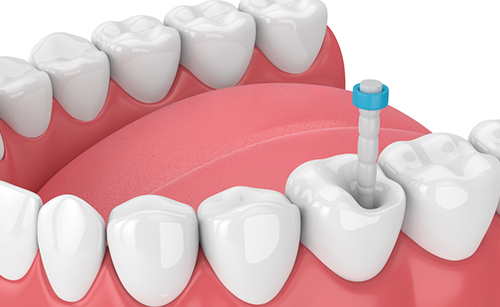Endodontics (Root Canal Treatment)
Endodontic therapy — also known as Root Canal Treatment — is an operation for tooth decay. If the tooth decay is severe and the infection is serious, root canal treatment is a must to clear the infection in the pulp chamber. The pulp chamber is the central part of a tooth, containing blood vessels and nerve trunks to supply nutrition to the tooth to keep it alive. The bacteria infection to the pulp chamber will cause nerve inflammation in the pulp and lead to severe pain, pulp necrosis and suppuration. At this stage, it’s necessary to have root canal treatment to completely remove the infected pulp tissue deep down by dental instruments and medication.
In general, after a full course of root canal treatment, the bacteria in the pulp should have completely removed and the symptoms of tooth decay and toothache improved. However, root canal treatment is a complicated surgery that may have chances for future recurrence in some cases. To eradicate tooth decay, you need to find a professional dentist for the root canal treatment.
ROOT CANAL TREATMENT
Root canal treatment involves cleaning, shaping and disinfecting the infected/ affected pulpal tissues. Finally places a root filling to seal the root canal space.
When to use it?
When a tooth is badly decayed and when the pulp becomes infected. Root canal treatment is a pain free dental procedure to prevent further spread of infection, dental abscess and pain.

Key information
- Root canal treatment success rate can be as high as 95%.
- A fixed prosthesis (crown) is recommended after root canal treatment to prevent tooth from cracking.
Procedures for root canal treatment
- Local anaesthesia
Local anaesthesia is usually used before the operation. Since the surgery involves penetration into the pulp chamber, narcotic drug is necessary to reduce the pain brought by the operation. - Remove cavities (if applicable) and open the pulp chamber
After local anaesthesia, the dentist will use the instrument to remove the cavity and the old fillings outside the pulp chamber, and open up the pulp chamber for further treatment. - Enlarge the root canal and clean with medication
After the pulp chamber is opened, the dentist can proceed to enlarge the root canal and rinse it with medication. At this step, the dentist will remove the necrotic tissue from the pulp chamber and disinfect it thoroughly. - Root canal filling
After the removal of the tissue of the pulp, the space of the pulp chamber will be sealed by the filling materials (gutta-percha, root canal sealer). The more complete the seal, the less chance for bacterial infection in future. - Put on a crown
After the operation, the tooth becomes more fragile and needs to be protected from fracture to avoid extraction or bacterial infection. Therefore, putting on a high-quality dental crown is an important process that needs careful execution. Studies have shown that for a small molar with a large area undergone root canal treatment but with no crown for protection, there’s 50% opportunity of extraction caused by fractures in the first 3 years.


